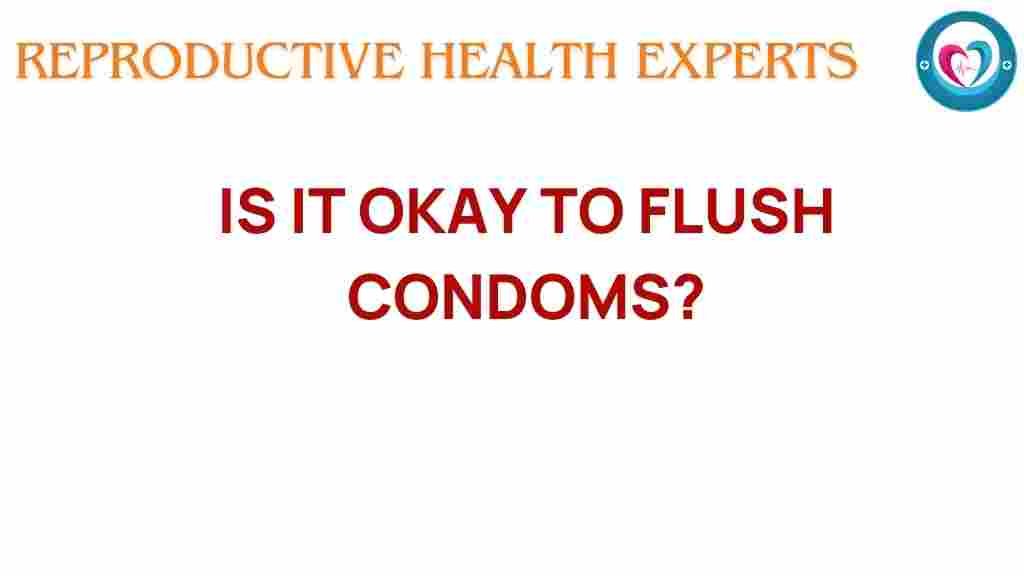The Hidden Dangers: Is It Okay to Flush Condoms?
When it comes to maintaining proper sanitation in our homes, many people might not think twice about what goes down the toilet. One common item that often ends up in the flush is condoms. However, the question remains: is it okay to flush condoms? Understanding the implications of this action is crucial, especially when we consider plumbing issues, environmental impact, and waste management. In this article, we will explore the hidden dangers of flushing condoms and raise public awareness about this important topic.
Understanding the Risks of Flushing Condoms
Flushing condoms may seem like a convenient way to dispose of them, but it can lead to serious plumbing issues. Here are some of the risks associated with flushing condoms:
- Clogs and Blockages: Condoms are made of latex or polyurethane, materials that do not break down easily in water. When flushed, they can accumulate in pipes, leading to significant clogs and blockages.
- Impact on Sewage Systems: Even if a condom makes it past your toilet, it can still cause problems in larger sewage systems. Wastewater treatment facilities are not designed to handle such items, potentially leading to costly repairs.
- Environmental Concerns: Flushing condoms can result in them entering our waterways, contributing to pollution and harming aquatic life.
What Happens When You Flush Condoms?
Flushing condoms can create a domino effect of problems. Here’s a step-by-step breakdown of what happens:
- Initial Flush: When a condom is flushed, it travels through your home’s plumbing.
- Pipe Accumulation: If the condom gets stuck in the pipes, it can trap other debris, leading to more significant blockages.
- Sewage Treatment: If it makes it to the sewage treatment facility, it may still not be processed correctly, potentially causing damage to the facility and impacting the environment.
Plumbing Issues: The Cost of Flushing Condoms
Dealing with plumbing issues can be expensive and inconvenient. Here are some potential plumbing problems that can arise from flushing condoms:
- Emergency Repairs: A clogged toilet or sewer line can require urgent attention, often resulting in costly emergency repairs.
- Service Fees: Hiring a plumber can incur service fees, which may be unnecessary had the condom been disposed of properly.
- Long-Term Damage: Persistent clogs can lead to long-term damage to pipes, potentially requiring complete replacement.
Environmental Impact of Flushing Condoms
The environmental impact of flushing condoms is another crucial aspect to consider. Here are some points to ponder:
- Water Pollution: Flushing condoms can lead to water pollution, as they do not decompose naturally. They can break down into microplastics, which contaminate water sources.
- Harm to Marine Life: Condoms entering waterways can pose risks to marine life, as animals may ingest them or become entangled.
- Waste Management Challenges: Waste management systems are not equipped to handle non-biodegradable items, complicating the treatment process.
Safe Disposal Methods for Condoms
So, what should you do with used condoms? Here are some safe disposal methods:
- Wrap and Throw: Wrap the used condom in tissue or toilet paper and dispose of it in the trash.
- Use a Container: Keep a small container in your bathroom for disposing of used condoms securely.
- Educate Others: Share this information with sexual partners and friends to raise public awareness about proper condom disposal.
Sexual Health and Public Awareness
Maintaining sexual health is essential for everyone, and proper disposal of condoms plays a role in that. Public awareness about issues surrounding condom disposal can lead to better practices. Here’s how:
- Education Campaigns: Communities can benefit from educational campaigns focused on sexual health and proper disposal practices.
- Open Conversations: Encourage open dialogue about sexual health and disposal methods among friends and partners.
- Promote Awareness: Utilize social media and local events to promote awareness about the environmental and plumbing issues related to flushing condoms.
Troubleshooting Tips for Plumbing Issues
If you suspect that you’ve already flushed a condom and are experiencing plumbing issues, consider these troubleshooting tips:
- Check for Backups: If your toilet is backing up, it may be a sign of a clog. Avoid flushing more water until the issue is resolved.
- Use a Plunger: If you’re comfortable, try using a plunger to dislodge the clog. This may help if the condom is still accessible.
- Call a Professional: If DIY methods do not resolve the issue, it’s best to call a plumber to investigate further.
Conclusion
In conclusion, flushing condoms is not a safe or responsible practice. The potential for plumbing issues, environmental impact, and the challenges related to waste management are significant. By raising public awareness and promoting safe disposal methods, we can help protect our plumbing systems and the environment while maintaining sexual health. Remember, it’s always better to wrap and throw than to flush condoms.
For more information on waste management practices, visit this resource. To learn more about sexual health, check out this informative article.
This article is in the category Prevention and created by ReproductiveHealthExperts Team
